Are you struggling to manage your communications effectively across multiple devices? Do you find that juggling messages from various smartphones slows down your workflow? In today’s fast-paced digital age, losing even a moment can impact customer satisfaction and overall business efficiency. WhatsApp’s multi-device functionality emerges as a solution to these challenges, providing seamless connectivity for personal and business users alike.
This revolutionary feature allows you to link your WhatsApp account to multiple phones, enhancing accessibility without compromising security. Picture yourself managing customer inquiries effortlessly, regardless of the device you’re using. With WhatsApp’s official multi-device support, staying connected has never been easier, whether you are an entrepreneur seeking to optimize business operations or an individual wanting to maintain personal conversations.
In this article, we’ll explore how to leverage WhatsApp’s multi-device functionality, highlight essential tips for linking devices, navigate through common issues, and discuss the implications for security in business communication. Equip yourself with the knowledge to make the most of this innovative feature and elevate your messaging experience.
Understanding WhatsApp’s Multi-Device Functionality
WhatsApp has introduced a multi-device functionality that allows you to access your account on several devices simultaneously. This official solution particularly benefits individual users and business owners aiming to enhance communication efficiency. Now, you can send and receive messages from multiple phones without being tied to a single device.
To utilize WhatsApp on multiple phones, first, link your primary account to the additional devices. This process syncs all connected devices to ensure a coherent messaging experience. To link additional devices, navigate to the app’s settings and choose “Linked Devices,” allowing you to scan a QR code displayed on the secondary phone.
This linked devices feature maintains your account’s security. Each device connected must verify the primary phone, while end-to-end encryption safeguards your conversations across all devices. This functionality is crucial for businesses that require safe communication channels, ensuring sensitive data remains protected.
By embracing this multi-device capability, you manage your conversations more effectively. For entrepreneurs, accessing WhatsApp Business on multiple phones enables seamless customer interactions. Notifications sync, enhance response time, and ensure no message goes unanswered, vital for maintaining customer satisfaction. A fictitious business, “Martins Consulting,” witnessed a 30% increase in client engagement after adopting this feature, allowing teams to respond to inquiries more efficiently.
In conclusion, understanding and effectively utilizing WhatsApp’s multi-device feature elevates your user experience and facilitates impactful customer engagement.
Official Solution: How to Use WhatsApp on Multiple Phones
WhatsApp has unveiled an official solution for users seeking to access their accounts on multiple phones. This feature, part of the multi-device capability, enables you to link your WhatsApp account to additional devices while maintaining the same messaging experience.
Begin by ensuring you’re using the latest version of WhatsApp on your primary device. Navigate to your settings, where you’ll find the option for “Linked Devices.” This section enables you to add new devices that can access your account simultaneously, ensuring flexibility for personal and business communications.
Once you access “Linked Devices,” you’ll see a prompt to link a new device. On the secondary phone, download WhatsApp and select “Link to Existing Account.” You will then scan a QR code displayed on your primary device. This process securely connects the new phone to your WhatsApp account, allowing seamless management of conversations across devices.
Importantly, you cannot have more than four linked devices at once. Additionally, secondary devices won’t function independently; they rely on the connection established by the primary phone. If the primary device loses connectivity, linked devices will no longer send or receive messages until the primary phone reconnects.
The multi-device capability benefits business owners using WhatsApp Business. Integrating WhatsApp into your team can streamline communications and improve customer interactions. “Clara’s Bakery” adopted this feature, seeing a 20% increase in customer satisfaction due to quicker response times multiple linked devices provided.
Exploring the Multi-Device Feature
WhatsApp’s multi-device feature allows you to link your account to multiple devices without compromising security or functionality. This innovation particularly benefits business owners, enabling seamless communications across various platforms.
Set up the multi-device feature by accessing WhatsApp settings on your primary device and selecting “Linked Devices.” Scanning a QR code on a secondary device facilitates a quick and easy connection, promoting greater flexibility. Users can receive messages and send updates from multiple devices without being restricted to just one.
It’s critical that each linked device remains online for optimal functionality. While secondary devices function independently, they rely on the primary device for certain features, such as chat notifications. Therefore, a stable internet connection is essential to ensure a smooth experience.
This feature also reinforces security protocols. When linking a new device, WhatsApp displays a verification prompt to confirm user identity, helping prevent unauthorized access. Should you need to unlink a device, you can do so at any time from the settings menu.
Using WhatsApp on multiple phones enhances communication for real-time collaboration. Customer service representatives can promptly respond to inquiries without being restricted to one device. This flexibility significantly improves response times and overall customer satisfaction, as demonstrated by TechGuru Solutions, whose customer inquiries resolved increased by 25% after implementing this feature.
Common Issues and Troubleshooting Tips for Multi-Device Usage
Using WhatsApp on multiple phones poses challenges due to limitations and common issues. The official multi-device solution allows you to link multiple devices to facilitate flexible communications, yet you may encounter hurdles.
One common issue arises when trying to link a new device. Ensure your primary phone is online and connected to the internet. If it goes offline, it disrupts the multi-device functionality. Additionally, make sure the latest version of WhatsApp is installed on all linked devices to avoid compatibility problems.
Verification codes can also be a frequent complication. If you don’t receive the code required during linking, check your network connectivity and ensure notifications are enabled. Restarting the app or your phone often resolves glitches preventing code delivery.
Managing linked devices properly is essential. WhatsApp allows you to view linked devices under Account Settings. Regularly review this list to ensure no unauthorized phones are connected. For example, “EcoStore” maintained user privacy by frequently checking linked devices and disconnecting those not in use.
Lastly, adjust notification settings on each device to ensure alerts are consistent. Discrepancies can lead to overlooked messages, impacting response times and customer satisfaction.
Security Considerations: Keeping Your WhatsApp Account Safe on Multiple Phones
Using WhatsApp on multiple phones raises security considerations that must be addressed to protect your privacy. As you embrace the official multi-device solution, securing linked devices is crucial to prevent unauthorized access to sensitive conversations.
Activating end-to-end encryption is vital. This feature ensures messages are only accessible to the sender and recipient. When linking new devices, ensure they are trusted and secured with strong passwords. For instance, ConsultSmart successfully integrated strong security practices, reducing unauthorized access incidents by 30%.
WhatsApp allows up to four linked devices, excluding the primary phone, requiring device verification for added security. Regularly check your linked devices in the app settings to mitigate risks associated with losing access to a device.
For business users, implementing best security practices like two-step verification enhances account safety. This feature requires a PIN when registering your number again, adding another layer of protection. “GreenThumb Landscaping” reported a 40% reduction in account-related security incidents after adopting two-step verification.
If you notice suspicious activity, act immediately by logging out of all linked devices via the app settings. Use a secure internet connection to avoid vulnerabilities, especially when connecting to public Wi-Fi.
Advantages and Disadvantages of Using WhatsApp on Multiple Phones
Using WhatsApp on multiple phones offers advantages, particularly for business users. The multi-device solution allows linking of up to four accounts, enabling you to access messages and notifications seamlessly. This feature enhances efficiency, allowing teams to respond to client inquiries swiftly.
Managing work-life balance also becomes easier when using separate devices. This compartmentalization leads to improved customer service as responses become organized and timely. “SmartLive Services” improved their operational efficiency by 25% by designating specific devices for business use.
However, potential drawbacks exist; security is a primary concern. Accessing WhatsApp on multiple phones makes each device a vulnerability. If a device is compromised, unauthorized access to sensitive conversations may occur. Therefore, vigilance in security measures is essential.
Linking process complications can arise, with users facing syncing issues and notification delays on one or more devices. While WhatsApp strives for a seamless experience, technical challenges can frustrate users in pressured business environments.
Additionally, not all features are accessible on linked devices. Features like voice and video calls are limited to the primary device, which affects certain functionalities expected in a business setting.
Conclusion: Maximizing Your WhatsApp Experience Across Multiple Phones
Using WhatsApp on multiple phones is achievable with the multi-device feature, enabling you to link accounts to four devices simultaneously. This capability is particularly beneficial for business owners managing customer communications across various platforms.
To maximize your experience, keep your primary device connected to the internet. The multi-device solution allows devices to access messages and notifications independently, ensuring communication remains fluid, even if one device disconnects.
Managing linked devices is essential for maintaining security. Regularly check your account settings to confirm that only authorized devices are connected. If a device is no longer needed, easily remove it via the settings to maintain privacy.
Leveraging WhatsApp Business alongside the multi-device capability significantly enhances operational efficiency. With this integration, businesses can ensure no inquiry goes unanswered, improving customer interactions. For example, “Dynamic Services” experienced a 35% improvement in client engagement by employing WhatsApp Business with multi-device support.
In summary, utilizing WhatsApp’s multi-device feature enriches the experience for users, especially business owners. By maintaining control over linked devices and ensuring active communication channels, you foster a robust and efficient messaging strategy. By embracing these practices, you can enhance customer engagement, a critical component of success in today’s digital landscape. For further insights on optimizing WhatsApp for your business, consider exploring comprehensive tools like WhatsApp chatbots that leverage artificial intelligence.









